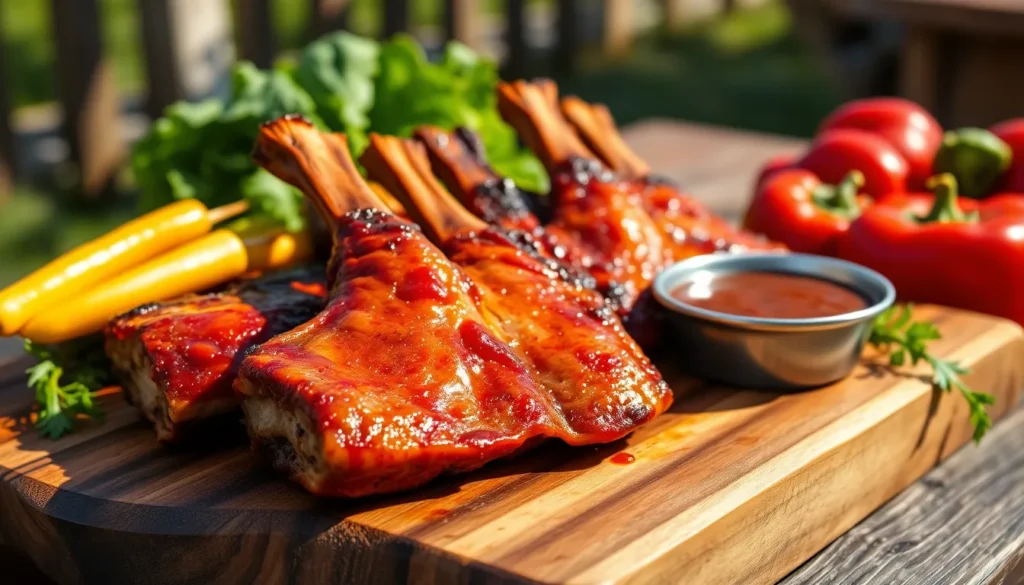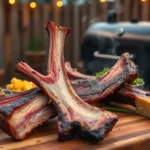BBQ pig feet might sound intimidating but we’re here to show you why this Southern delicacy deserves a spot on your dinner table. These tender morsels pack incredible flavor when slow-cooked and slathered in smoky barbecue sauce. What starts as tough collagen transforms into silky gelatin that’ll make your taste buds sing.
We’ve perfected this traditional recipe that turns humble pig feet into fall-off-the-bone goodness. The secret lies in our two-step process: first we braise them until fork-tender then finish with a caramelized barbecue glaze. Don’t let preconceived notions stop you from experiencing this soul food classic.
Once you master our BBQ pig feet recipe you’ll understand why generations have treasured this economical cut. We’ll guide you through every step from prep to plate ensuring your first attempt becomes a family favorite that’ll have everyone asking for seconds.
Ingredients
We’ve carefully selected ingredients that work together to transform tough pig feet into succulent barbecue perfection. Our recipe combines traditional Southern seasonings with a rich homemade barbecue sauce for authentic flavor.
For the Pig Feet
- 4 pounds fresh pig feet, cleaned and split
- 2 tablespoons kosher salt
- 1 large yellow onion, quartered
- 4 garlic cloves, smashed
- 2 bay leaves
- 1 tablespoon black peppercorns
- 8 cups water
- 2 cups apple cider vinegar
For the BBQ Rub
- 2 tablespoons brown sugar
- 1 tablespoon paprika
- 1 tablespoon garlic powder
- 1 tablespoon onion powder
- 2 teaspoons chili powder
- 2 teaspoons ground cumin
- 1 teaspoon cayenne pepper
- 1 teaspoon black pepper
- 1 teaspoon kosher salt
For the BBQ Sauce
- 1 cup ketchup
- 1/2 cup apple cider vinegar
- 1/4 cup brown sugar
- 2 tablespoons Worcestershire sauce
- 1 tablespoon yellow mustard
- 1 tablespoon molasses
- 2 teaspoons liquid smoke
- 1 teaspoon garlic powder
- 1 teaspoon onion powder
- 1/2 teaspoon smoked paprika
- 1/4 teaspoon cayenne pepper
Equipment Needed
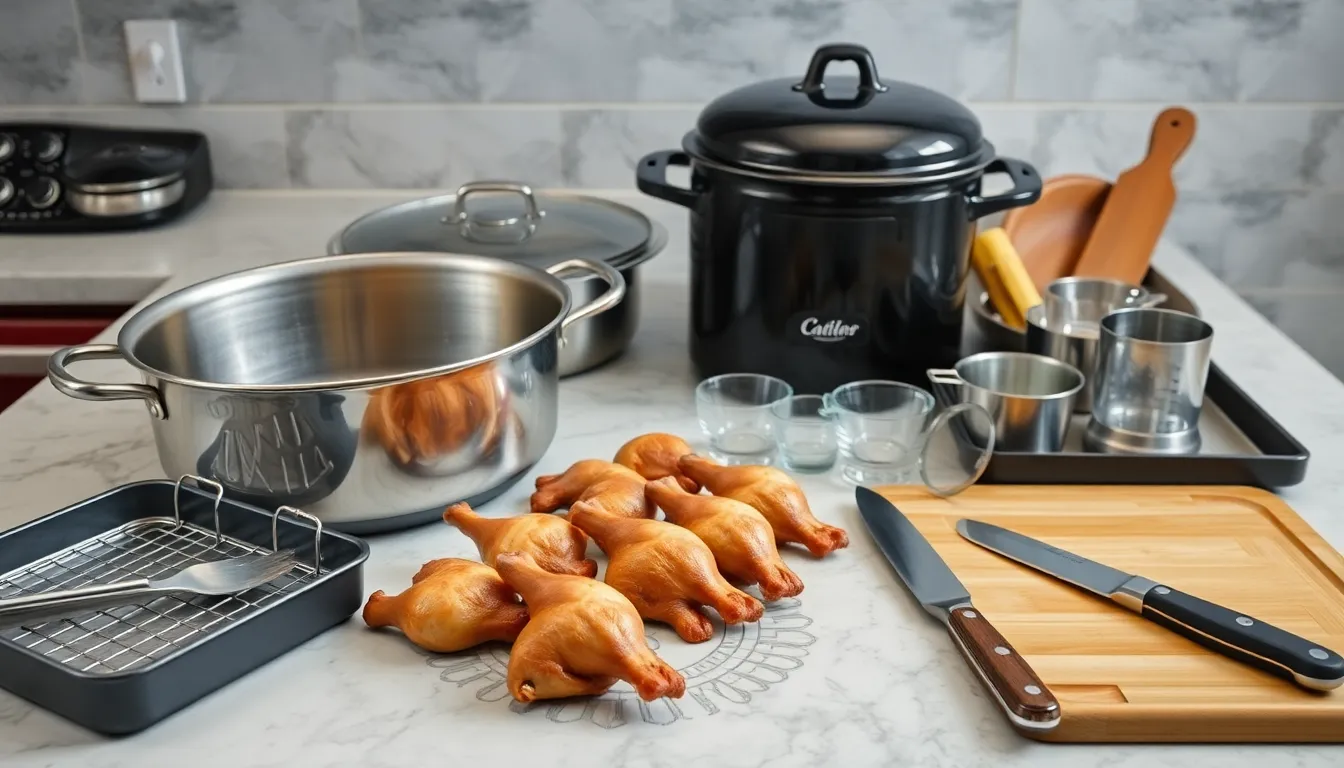
Success with BBQ pig feet requires having the right tools for this traditional two-step cooking process. We recommend gathering these essential pieces of equipment before starting your culinary adventure.
Large Pot or Dutch Oven serves as the foundation for braising our pig feet. This heavy-bottomed vessel needs to accommodate 4 pounds of pig feet along with all the braising liquid. A 6-quart capacity works perfectly for this recipe.
Wire Rack becomes crucial for the smoking or resting phase between cooking steps. This allows proper air circulation around each piece while preventing sticking to surfaces.
Smoker or Grill transforms ordinary braised pig feet into authentic BBQ perfection. Temperature control matters significantly here since we need consistent heat at 250°F for optimal results.
Oven provides the finishing touch for our caramelized barbecue glaze. Most home cooks find this more reliable than maintaining precise grill temperatures for the final glazing step.
Sturdy Tongs protect your hands while handling hot pig feet throughout the cooking process. Stainless steel versions with good grip work best for maneuvering these substantial pieces safely.
Sharp Knife and Cutting Board help with any trimming or splitting needed before cooking begins. Some recipes call for splitting the pig feet for better seasoning penetration.
Measuring Cups and Spoons ensure accurate proportions for both the braising liquid and BBQ rub components. Precision matters when balancing the complex flavors in this dish.
Basting Brush applies that final layer of homemade barbecue sauce evenly across each piece. Silicone brushes withstand high heat better than traditional bristle versions.
Having these tools ready streamlines the entire cooking process and helps achieve restaurant-quality results at home.
Prep Work
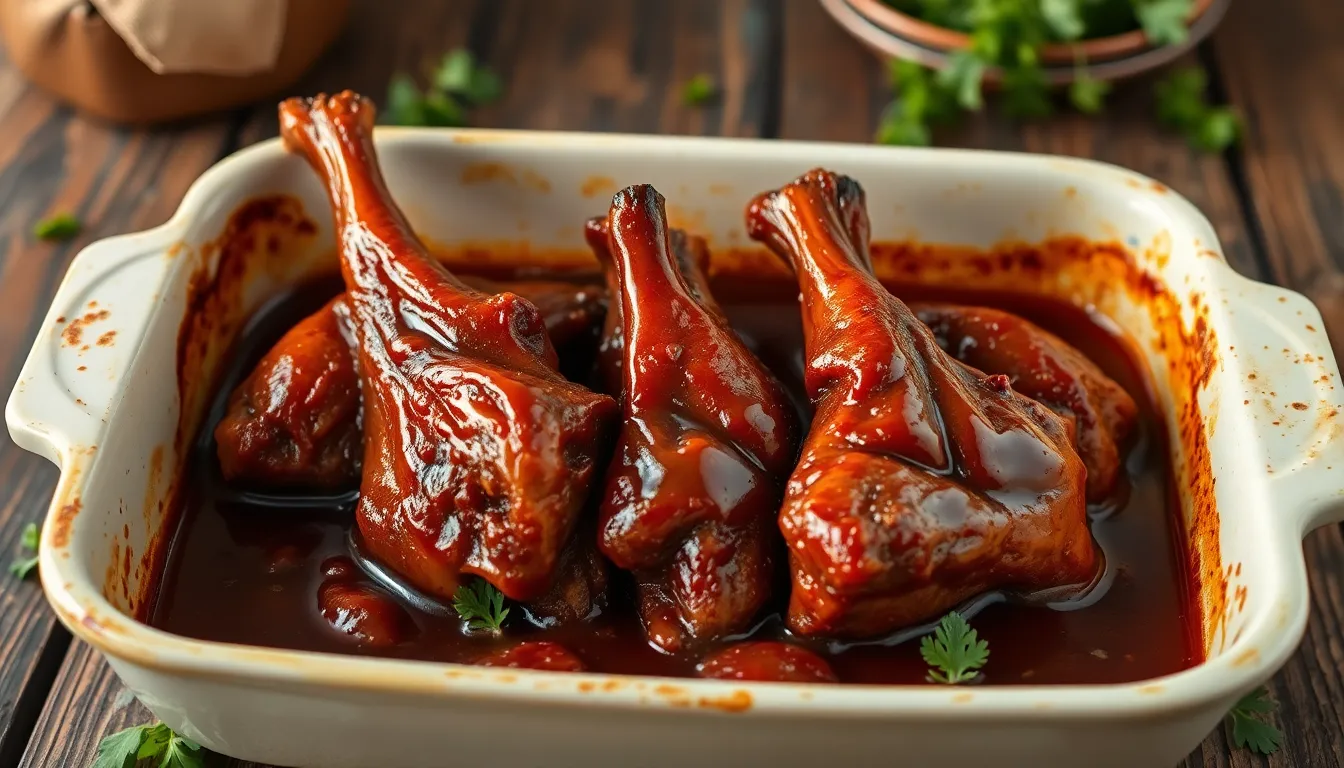
Proper preparation sets the foundation for achieving tender, flavorful BBQ pig feet that will impress your guests. We’ll walk through each essential step to ensure your pig feet are perfectly cleaned, seasoned, and ready for the barbecue transformation.
Cleaning and Preparing the Pig Feet
We begin by using a lighter flame to carefully singe the skin of each pig foot, removing any remaining hair that may be present. After singeing, we thoroughly wash the feet under cold running water to eliminate all surface impurities and debris.
Next, we place the pig feet in a large pot filled with cold water and bring it to a rolling boil for approximately 30 minutes. This crucial scalding step draws impurities to the surface, making them easier to remove. We then drain the water completely and wash the feet once more to eliminate any scum or residue that has surfaced.
For the braising preparation, we return the cleaned pig feet to our pot with fresh cold water. We add chopped onion, bell pepper, and celery to create an aromatic base that will infuse flavor into the meat. Our seasoning blend includes 2 tablespoons of vinegar, red pepper flakes, seasoned salt, and black pepper to enhance the natural flavors.
We cover the pot and allow everything to simmer for 2.5 to 3 hours until the meat becomes fork-tender. Throughout this process, we skim the surface occasionally to remove any additional impurities that rise to the top.
Making the BBQ Rub
While our pig feet simmer, we prepare the dry rub that will add depth and complexity to the final dish. We combine kosher salt, black pepper, red pepper flakes, and garlic powder as our base ingredients. For additional flavor layers, we can include smoked paprika for a smoky note or brown sugar for subtle sweetness.
We mix all dry rub ingredients thoroughly in a bowl, ensuring even distribution of each component. The rub can be applied liberally to the pig feet either before the initial boiling process or after they’ve been braised, depending on our preferred flavor intensity. Some recipes focus more heavily on wet BBQ sauce application, so we can adjust or reduce rub quantities accordingly to balance the overall flavor profile.
Preparing the BBQ Sauce
Our BBQ sauce serves as the crowning element that transforms braised pig feet into true barbecue excellence. We can use our favorite store-bought variety or create a homemade version using ketchup as the base, combined with apple cider vinegar, brown sugar, Worcestershire sauce, yellow mustard, and carefully selected spices.
For homemade sauce preparation, we blend all ingredients together and simmer the mixture until it reaches the desired consistency and flavor balance. Once our pig feet have finished their braising process and become tender, we arrange them in a baking dish and generously coat each piece with our prepared BBQ sauce.
We bake the sauced pig feet uncovered at 350°F for about 15 minutes to begin the caramelization process. Then we reduce the heat to 300°F and continue baking for an additional 30 to 35 minutes, allowing the sauce to penetrate the meat while developing a beautiful caramelized exterior that locks in all the flavors.
Instructions
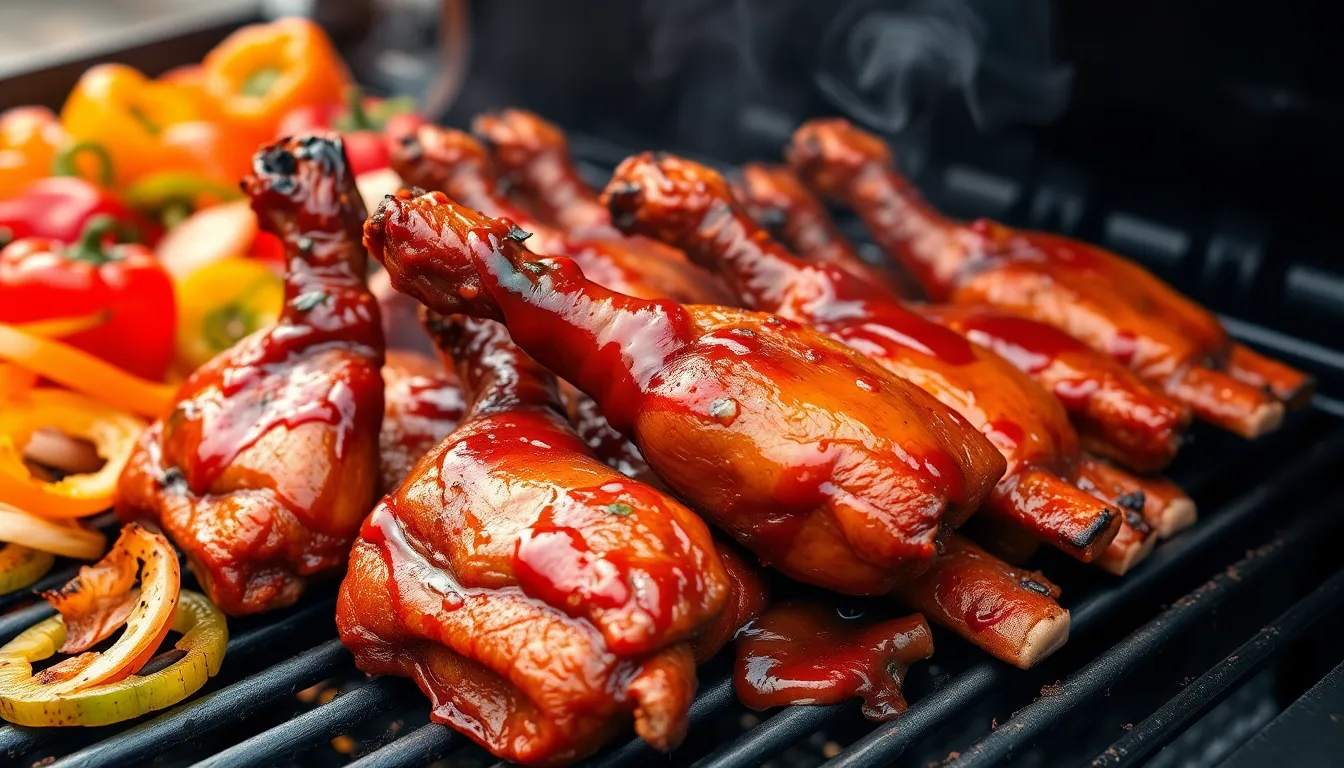
Now that we have our ingredients and equipment ready, let’s walk through the step-by-step process to create these mouthwatering BBQ pig feet that will have your family asking for seconds.
Seasoning the Pig Feet
We begin by thoroughly cleaning the pig feet to ensure optimal flavor absorption. Use a lighter to carefully singe any remaining hair from the skin surface, then wash the feet under cold running water. Pat them completely dry with paper towels before proceeding to the seasoning stage.
Create our aromatic seasoning broth by combining chopped onions, diced green bell peppers, celery stalks, apple cider vinegar, kosher salt, freshly ground black pepper, and red pepper flakes in a large mixing bowl. This flavorful mixture will penetrate deep into the meat during the cooking process. Rub the seasoning blend generously over each pig foot, ensuring every surface receives adequate coverage for maximum flavor infusion.
Pre-cooking the Pig Feet
Place the seasoned pig feet in our large pot or Dutch oven, then add enough water to cover them by at least 2 inches. Bring the mixture to a rolling boil over high heat to remove any impurities that may affect the final taste. Drain the water completely and rinse the pig feet under cold running water to eliminate any foam or residue.
Return the cleaned pig feet to the pot with fresh seasoned water, bay leaves, and our aromatic vegetables. Cover the pot and reduce heat to maintain a gentle simmer for 2½ to 3 hours. The meat should become fork-tender and easily pull away from the bone when properly cooked. Remove the pig feet from the cooking liquid and allow them to cool slightly before handling.
Preparing the Grill
Set up our grill for indirect cooking by creating two heat zones with medium temperature around 300°F to 350°F. Clean the grill grates thoroughly with a wire brush, then oil them generously using a paper towel dipped in vegetable oil. This prevents sticking and ensures even heat distribution across the cooking surface.
Position a drip pan filled with water beneath the cooler side of the grill to catch any drippings and maintain moisture levels. Allow the grill to preheat for 10 to 15 minutes before placing the pig feet on the cooking grates.
Grilling the Pig Feet
Transfer the tender pig feet to the cooler side of our preheated grill, positioning them away from direct flame. Close the lid and allow them to smoke for 15 to 20 minutes, turning occasionally with sturdy tongs to ensure even browning on all sides.
Watch for the development of a golden brown exterior and listen for the satisfying sizzle that indicates proper caramelization. The internal temperature should reach 160°F when measured with a meat thermometer. Move the pig feet to the hotter side of the grill during the final 5 minutes to achieve a crispy, smoky finish.
Applying the BBQ Sauce
Brush our homemade barbecue sauce liberally over each pig foot during the last 10 minutes of grilling time. The sauce will caramelize and create a glossy, flavorful coating that enhances both appearance and taste. Apply multiple thin layers rather than one thick coating to prevent burning.
Transfer the sauced pig feet to a preheated 350°F oven for an additional 15 to 20 minutes to further caramelize the glaze. Baste with additional sauce every 5 minutes to build up rich, sticky layers that will make these BBQ pig feet absolutely irresistible. Remove from heat when the sauce appears glossy and slightly charred around the edges.
Cooking Tips and Techniques
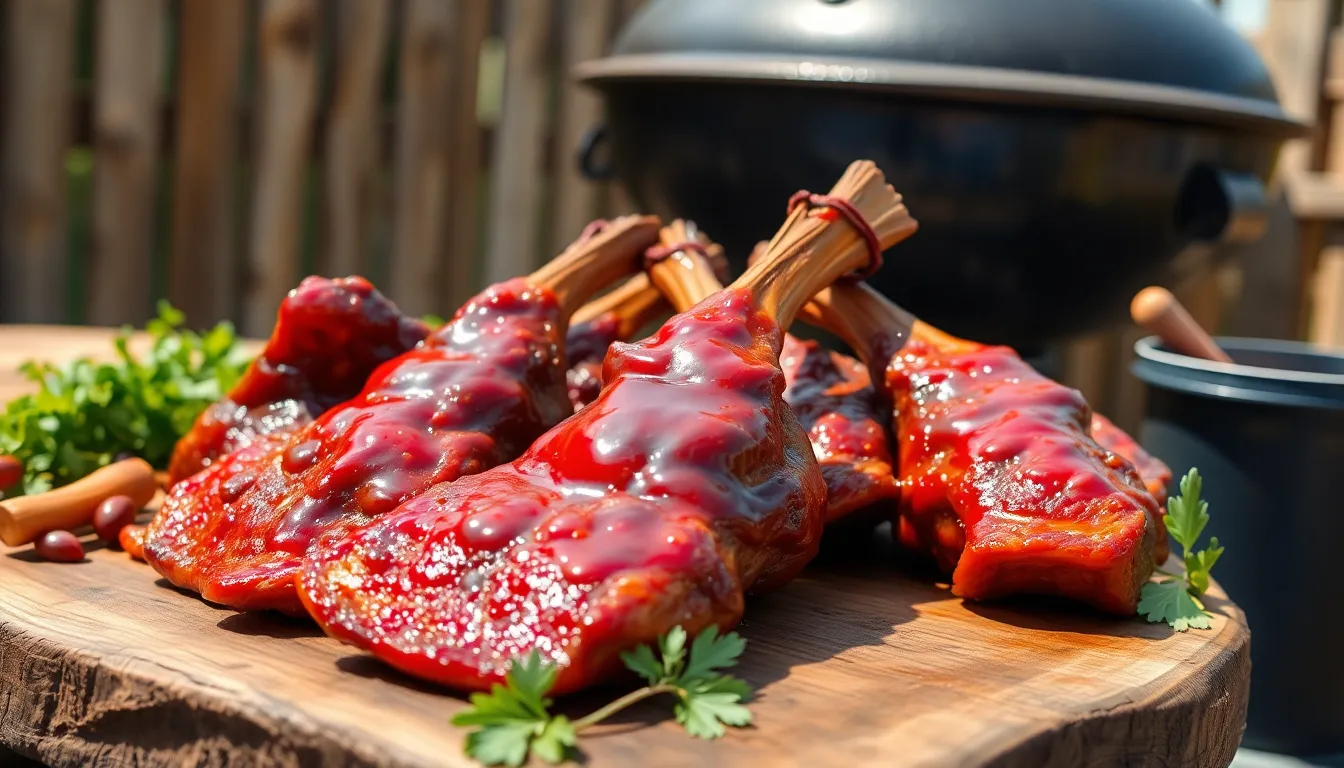
Mastering BBQ pig feet requires attention to exact techniques that ensure tender meat and crispy skin. We’ll share the essential tips that transform this challenging cut into a restaurant-quality dish.
Temperature Control
We maintain consistent low heat during the braising phase to achieve perfectly tender pig feet. Start by bringing the water and vinegar mixture to a rolling boil over medium heat, then immediately reduce to a gentle simmer. The simmering temperature should remain steady throughout the 2.5-hour cooking process to break down tough connective tissues without making the meat stringy.
When transitioning to the grill, we set up indirect heat zones to prevent burning the delicate skin before it crisps properly. Keep one side of your grill hot while maintaining a cooler zone around 300°F for the pig feet. For oven finishing, we begin at 350°F for the initial 15 minutes to activate the barbecue sauce, then reduce to 300°F for the remaining cooking time.
| Cooking Phase | Temperature | Duration |
|---|---|---|
| Initial Boiling | Medium Heat (Boiling) | Until boiling starts |
| Braising/Simmering | Low Heat (Gentle Simmer) | 2.5 hours |
| Grill Finishing | Indirect Heat (300°F) | 15-30 minutes |
| Oven Glazing | 350°F then 300°F | 15 + 35 minutes |
Timing Guidelines
Our timing approach breaks down into distinct phases that build flavor and texture. We begin the braising process by simmering the cleaned pig feet for approximately 2.5 hours until fork-tender. During this time, we occasionally skim foam from the surface and stir the pot to ensure even cooking.
After braising, we allow a brief resting period before applying our barbecue rub and transferring to the grill. The grilling phase typically requires 15 to 30 minutes on indirect heat, depending on your desired level of skin crispiness. We reserve the final 5 minutes of grilling for the first barbecue sauce application.
For our oven finishing technique, we bake the sauced pig feet for exactly 15 minutes at 350°F, then reduce the temperature and continue cooking for an additional 35 minutes. This two-temperature approach ensures the sauce caramelizes without burning while the meat stays succulent.
How to Check for Doneness
We test doneness using multiple sensory indicators to guarantee perfect results every time. The primary test involves piercing the meatiest part of each pig foot with a fork—it should slide in effortlessly without any resistance. Properly cooked pig feet will have meat that easily pulls away from the bone when gently tugged with tongs.
Visual cues provide equally important information about doneness. We look for skin that appears golden brown and slightly crispy on the outside while maintaining a tender, gelatinous texture underneath. The barbecue sauce should form a glossy, caramelized coating that doesn’t appear wet or runny.
The internal texture serves as our final confirmation of doneness. When we cut into a finished pig foot, the meat should appear moist and easily separate into tender strands. The connective tissues will have transformed into a rich, silky gelatin that coats your fingers when touched. Any remaining tough or chewy areas indicate the need for additional cooking time.
Serving Suggestions
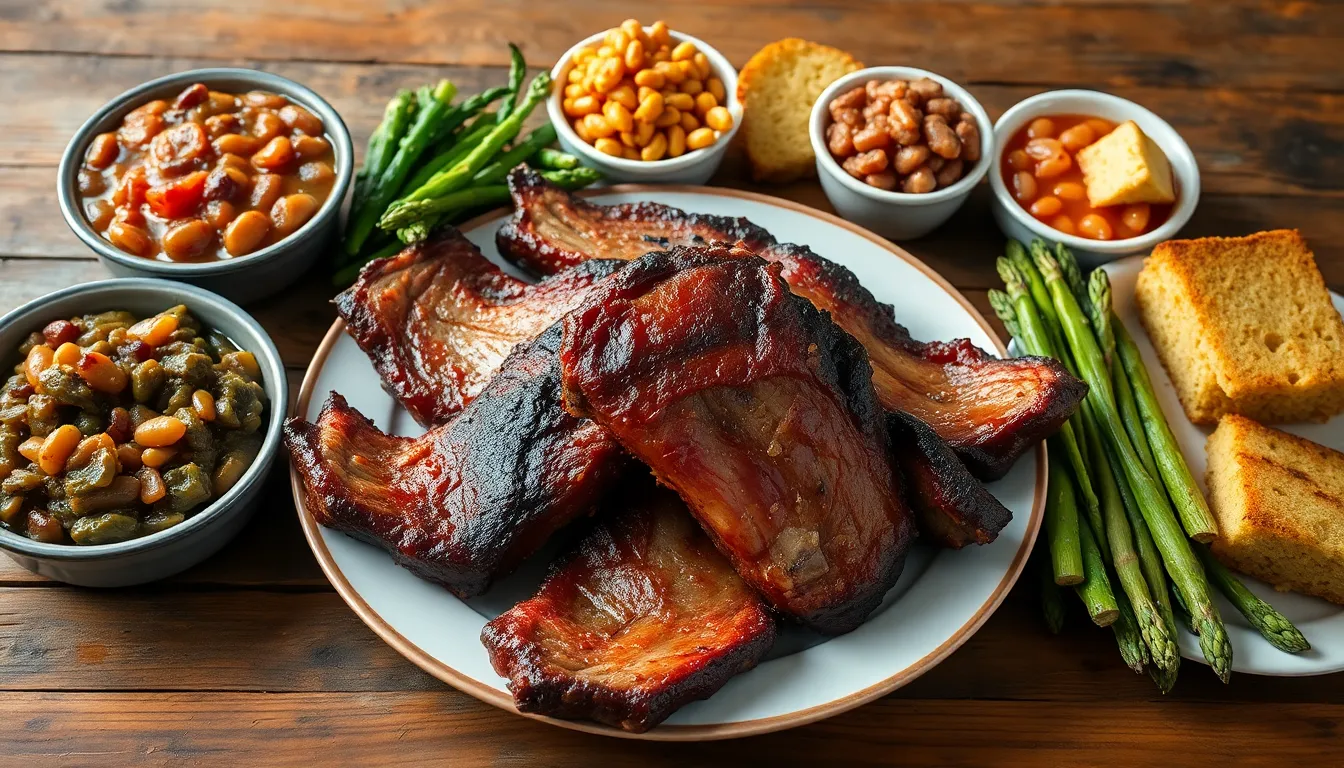
We transform our perfectly cooked BBQ pig feet into a memorable dining experience through thoughtful presentation and complementary accompaniments. The key lies in balancing the rich, smoky flavors with fresh sides and bold sauces that enhance rather than compete with the star of the show.
Best Side Dishes
Traditional Southern sides create the perfect foundation for our BBQ pig feet feast. Creamy collard greens provide a bitter contrast that cuts through the richness, while baked beans offer sweet and smoky notes that complement the barbecue flavors. Cornbread serves as an essential vehicle for soaking up the delicious drippings and sauce.
Mac and cheese delivers comfort food satisfaction alongside the tender meat. The creamy pasta creates a textural contrast against the gelatinous pig feet while adding familiar flavors to the plate. Dirty rice brings heartiness to the meal with its robust seasonings and satisfying grain base.
Fresh vegetables balance the intensity of our BBQ pig feet beautifully. Grilled asparagus adds a crisp, clean finish that refreshes the palate between bites. Simple roasted vegetables like carrots, Brussels sprouts, or green beans provide color and nutrition to round out the meal.
Creamy mashed potatoes create another excellent pairing option. Their smooth texture and mild flavor allow the barbecue seasonings to shine while providing a comforting base that soaks up the flavorful juices.
Sauce Pairings
Sweet and smoky barbecue sauce remains the classic choice for our pig feet. Traditional tomato-based sauces with brown sugar and molasses enhance the caramelized exterior while adding depth to each bite. Kecap manis offers an Indonesian twist with its thick, sweet soy base that creates an irresistible glaze.
Spicy condiments elevate the flavor profile dramatically. Sriracha provides clean heat that awakens the taste buds without overwhelming the smoky meat. Chile-garlic sauce adds both heat and umami depth that complements the rich collagen and tender meat.
Tangy vinegar-based sauces cut through the richness effectively. Apple cider vinegar mixed with a touch of brown sugar creates a Carolina-style sauce that brightens the entire dish. Tamarind sauce brings exotic tanginess that pairs surprisingly well with the deep barbecue flavors.
We recommend serving multiple sauce options in small bowls for dipping. This approach allows each diner to customize their experience while exploring different flavor combinations throughout the meal.
Storage and Reheating
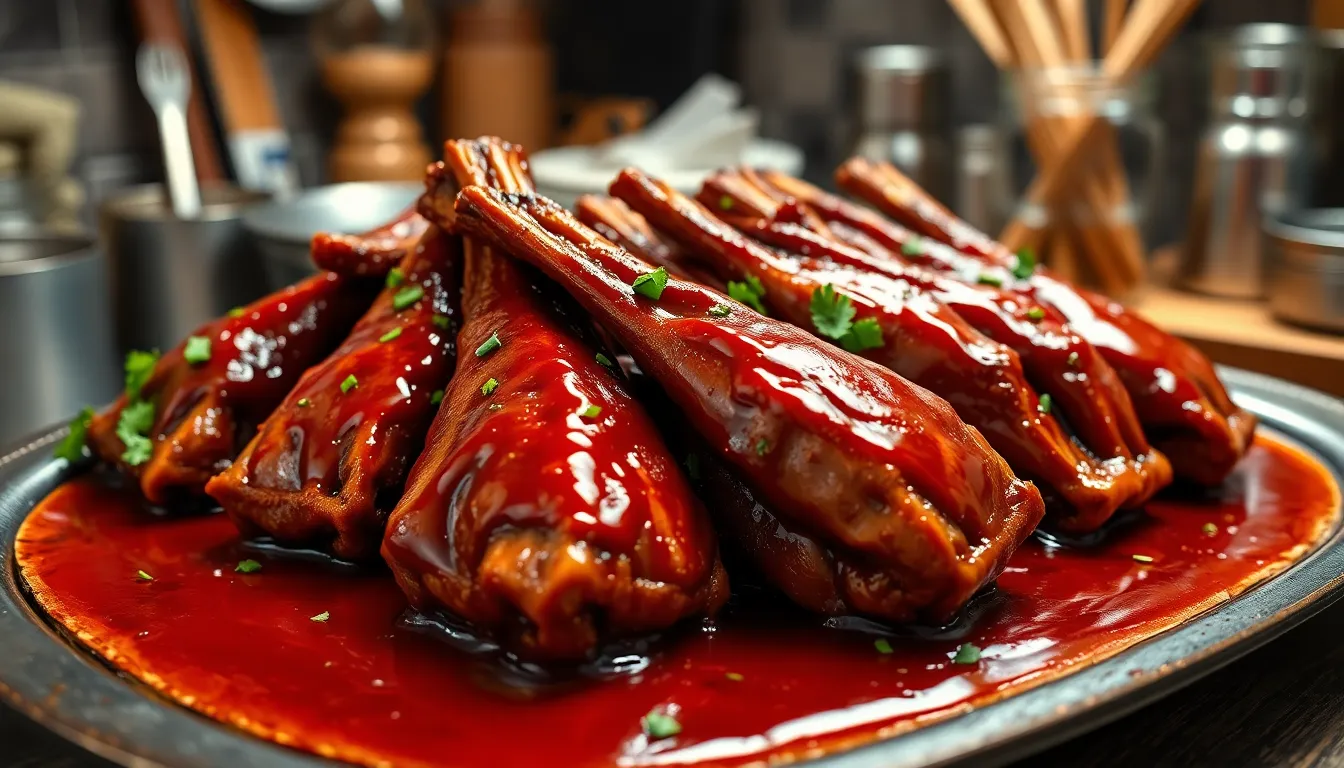
Our BBQ pig feet maintain their exceptional flavor and texture when stored and reheated properly. These smart storage strategies ensure you can enjoy this Southern delicacy at its best even after the initial cooking session.
Make-Ahead Instructions
We recommend preparing your pig feet up to the baking stage for maximum convenience. Complete the entire braising process and apply the initial barbecue rub before refrigerating the partially cooked pig feet. This approach allows the flavors to develop further during storage while maintaining the meat’s tender texture.
Store the braised pig feet in airtight containers for up to 2 days before finishing. Reserve the flavorful cooking broth separately as it becomes invaluable for the final reheating process. When ready to serve we simply reheat the pig feet and finish with the barbecue sauce baking stage for optimal flavor and tenderness.
Leftover Storage
Properly stored leftover pig feet remain delicious for 3 to 4 days in the refrigerator. Allow the cooked pig feet to cool completely before transferring them to airtight containers. We always save the reserved cooking broth in a separate container as it prevents the meat from drying out during storage.
| Storage Method | Duration | Temperature |
|---|---|---|
| Refrigerator | 3-4 days | 40°F or below |
| Freezer | 2-3 months | 0°F |
| Room Temperature | 2 hours maximum | Above 40°F |
For longer storage we wrap individual portions in plastic wrap before placing them in freezer-safe containers. Label each container with the date to track freshness and ensure food safety.
Reheating Methods
Our preferred oven method delivers consistently tender results without compromising texture. Preheat your oven to 300°F and place the pig feet in a baking dish with a splash of reserved broth. Cover tightly with foil and heat for 20 to 30 minutes until warmed throughout.
The stovetop method works exceptionally well for maintaining moisture. Gently simmer the pig feet in the reserved cooking broth over low heat until heated through. This technique prevents the meat from drying out while preserving the original flavors.
We also recommend the slow cooker approach for hands-off reheating. Set your slow cooker to low and add the pig feet with a small amount of broth or barbecue sauce. Heat for 1 to 2 hours until thoroughly warmed. This method ensures even heating while maintaining the meat’s succulent texture.
Recipe Variations
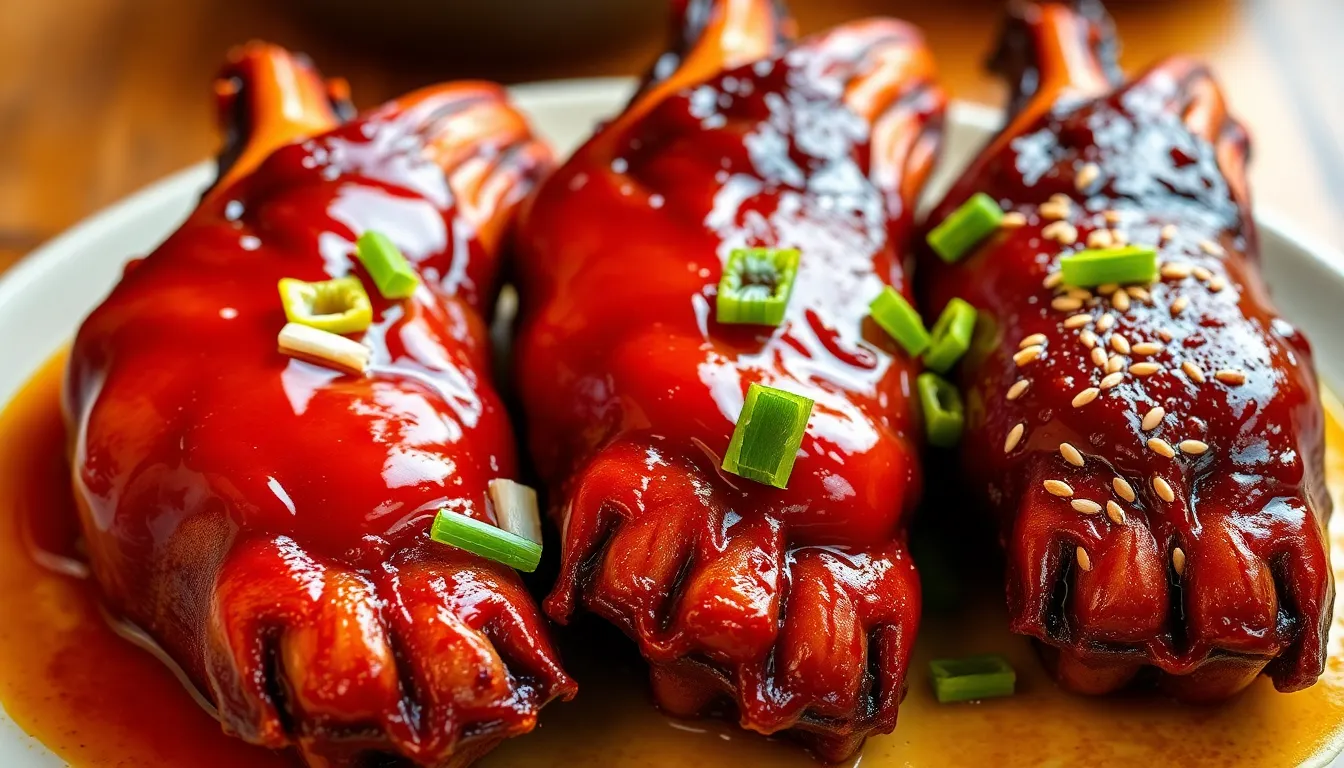
Transform our classic BBQ pig feet recipe into exciting new flavors with these three bold variations. Each adaptation maintains the essential braising technique while introducing unique seasonings and sauces that create distinct taste profiles.
Spicy BBQ Pig Feet
Heat lovers will appreciate this fiery twist on our traditional recipe. Add 2 tablespoons sriracha and 1 teaspoon cayenne pepper to the braising liquid during the initial cooking phase. Mix 1 tablespoon red pepper flakes and 2 teaspoons chili powder into your BBQ rub before applying to the cooked pig feet. We recommend using a spicy barbecue sauce or creating your own by combining our homemade sauce with additional hot sauce and a pinch of ghost pepper powder. The result delivers layers of heat that build gradually without overwhelming the rich pork flavor.
Asian-Style BBQ Pig Feet
Our Asian-inspired version brings sweet and savory elements that create an irresistible glaze. Replace the traditional braising liquid with a mixture of 1/2 cup kecap manis (sweet Indonesian soy sauce), 1/4 cup sriracha, 6 minced garlic cloves, 2 tablespoons fresh ginger, and 4 cups water. Braise the pig feet using this aromatic base for the same 2.5 to 3 hours until tender. After the initial cooking, brush the feet with additional kecap manis mixed with rice vinegar before grilling to achieve that glossy, caramelized finish. Garnish with sliced scallions and toasted sesame seeds for an authentic presentation that balances sweet, spicy, and umami flavors.
Smoky Bourbon BBQ Pig Feet
Bourbon adds sophisticated depth to this Southern-inspired variation that pairs perfectly with the rich pork. Incorporate 1/2 cup bourbon whiskey into the braising liquid along with our traditional seasonings and vegetables. The alcohol cooks off during the long braising process while leaving behind complex vanilla and caramel notes. Create a bourbon-infused BBQ sauce by adding 3 tablespoons bourbon and 1 teaspoon liquid smoke to our homemade sauce recipe. Brush this mixture onto the pig feet before the final oven glazing step. We suggest adding 2 teaspoons smoked paprika to enhance the smoky profile and create a beautiful mahogany color that makes this variation as visually appealing as it is delicious.
Conclusion
BBQ pig feet might seem intimidating at first but they’re truly worth the effort. Once you master the two-step cooking process we’ve outlined you’ll have a show-stopping dish that’s both economical and incredibly satisfying.
The key lies in patience during the braising phase and attention to detail when applying the final glaze. Whether you stick with our traditional recipe or experiment with the spicy Asian-style or bourbon variations there’s a flavor profile that’ll suit your taste preferences.
We encourage you to give this Southern classic a try. Your guests will be impressed by the tender fall-off-the-bone texture and rich smoky flavors. With proper storage techniques you can even prepare components ahead of time making this perfect for entertaining or meal prep.
Frequently Asked Questions
What are BBQ pig feet and why should I try them?
BBQ pig feet are a traditional Southern delicacy made from slow-cooked pork trotters coated in barbecue sauce. When cooked properly, the tough collagen transforms into tender, gelatinous meat with incredible flavor. They’re an economical cut that offers rich taste and are perfect for those wanting to explore authentic Southern cuisine.
How long does it take to cook BBQ pig feet?
The complete cooking process takes approximately 4-5 hours. This includes 2.5-3 hours of braising until tender, followed by grilling and oven glazing. The extended cooking time is essential for breaking down the collagen and achieving the signature tender texture that makes this dish so special.
What equipment do I need to make BBQ pig feet?
You’ll need a large pot or Dutch oven for braising, a smoker or grill for BBQ cooking, a wire rack, sturdy tongs, and an oven for final glazing. Additional helpful tools include a sharp knife, cutting board, measuring cups, and a basting brush for applying the barbecue sauce.
How do I know when BBQ pig feet are done cooking?
Properly cooked BBQ pig feet should be fork-tender, meaning the meat easily falls off the bone when pierced. The skin should appear golden brown and slightly crispy, while the internal meat should have a gelatinous texture. The cooking liquid should have reduced significantly during the braising process.
What sides pair well with BBQ pig feet?
Traditional Southern sides complement BBQ pig feet perfectly. Consider serving creamy collard greens, baked beans, cornbread, mac and cheese, dirty rice, or mashed potatoes. These hearty sides balance the rich flavors of the pig feet and create an authentic Southern dining experience.
How should I store and reheat leftover BBQ pig feet?
Store leftover BBQ pig feet in airtight containers in the refrigerator for 3-4 days or freeze for 2-3 months. For reheating, use the oven at 350°F, stovetop with reserved broth, or slow cooker on low heat. This maintains the tender texture and prevents the meat from drying out.
Can I make variations of the traditional BBQ pig feet recipe?
Yes! Popular variations include Spicy BBQ Pig Feet with sriracha and cayenne, Asian-Style with kecap manis and ginger, or Smoky Bourbon BBQ Pig Feet. Each variation maintains the essential braising technique while introducing unique flavor profiles to suit different taste preferences.
What’s the secret to tender BBQ pig feet?
The key is the two-step cooking process: first braising the pig feet in seasoned liquid until the collagen breaks down, then applying barbecue sauce and finishing on the grill or in the oven. Proper temperature control and allowing sufficient braising time are crucial for achieving tender, flavorful results.

